A warning, this post is all about numbers. If this is not your kind of thing, skip this one.
This is a
recurring topic and a myth that is in the media every now and then. A woman's work is never done and while she has a career, she still has to do most of the housework while hubby does nothing more than sitting on the couch watching TV. Luckily, the Bureau of Labour Statistics has counted the amount of minutes, men and women work so we can see how fair men and women share their work.
About this Survey:
American Time Use Survey
Data collection for the ATUS began in January 2003. Sample cases for the survey are selected monthly and interviews are conducted continuously throughout the year. In 2008, approximately 12,700 individuals were interviewed. Estimates are released annually.
I drew all numbers from
table 3. Using these columns.
House - Household Activities
Care1 - Caring for and helping household members
Care2 - Caring for and helping non-household members
Work - Work and work-related activities
Edu - Educational activities
A first look.
Time spent in primary activities (1) for the civilian population by age, sex, race, Hispanic or Latino ethnicity, marital status, and educational attainment, 2008 annual averages
Average hours per day spent in primary activities (2)
House Care1 Care2 Work Edu Sum
Men, 15 years and over...... 1.30 .36 .18 4.52 .30 6.66
Women, 15 years and over.... 2.13 .70 .27 2.99 .52 6.61
Very obvious, the average man works more, while the average woman does more childcare and housework. In total not much of a difference (men working 3 minutes more).
A closer look.
House Care1 Care2 Work Edu Sum
Marital status and sex:
Married, spouse present.... 2.01 .76 .23 4.06 .10 7.16
Men....................... 1.50 .55 .18 4.94 .06 7.23
Women..................... 2.53 .97 .29 3.16 .15 7.10
Other marital statuses..... 1.40 .27 .22 3.35 .90 6.14
Men....................... 1.05 .12 .19 3.98 .88 6.22
Women..................... 1.70 .41 .25 2.82 .91 6.09
Again we have a small difference with a little bit more workload for men. One could argue that I should have taken "Purchasing goods and services" into account which of course includes buying groceries for the family. While this is true I could argue that his
also includes personal shoppings, nail, tanning and hair salons, which, taking a wild guess here, women spend more time with than men. But before we start bickering about numbers, even when we include them in total the difference is between 11-12 minutes this time with slightly more workload for women.
I have seen another take on this issue. Sometimes an analysis focuses on leisure time and we see men having more leisure time than women. This is true for this survey as well. Now we know there is not that much of a difference when it comes to the daily grind. So why do women have less leisure time? A look at the other columns:
Personal - Personal care activities
Shop - Purchasing goods and services
Eat - Eating and drinking
Org - Organisational, civic and religious activities
Tele - Telephon calls, mails and e-mails
Leisure - Leisure and sports
Average hours per day spent in primary activities (2)
Personal Eat Shop Org Tele Other Leisure Sum
Men, 15 years and over...... 9.22 1.28 .60 .30 .14 .17 5.52 17.23
Women, 15 years and over.... 9.55 1.18 .92 .37 .28 .24 4.86 17.40
Marital status and sex:
Married, spouse present.... 9.11 1.32 .82 .40 .16 .21 4.81 16.83
Men....................... 8.92 1.39 .65 .38 .10 .17 5.17 16.78
Women..................... 9.31 1.26 .99 .43 .22 .25 4.44 16.90
Other marital statuses..... 9.71 1.12 .71 .26 .27 .19 5.60 17.86
Men....................... 9.61 1.15 .54 .20 .18 .16 5.96 17.80
Women..................... 9.81 1.10 .85 .31 .35 .22 5.30 17.94
Time differences here between 7 and 10 minutes. Also we can see that difference in leisure time is not a result of unfair distribution of work. Interestingly the above confirms many stereotypes. Men spend more time eating and doing sports and other leisure activities, while women take more time for personal care, shopping, chatting with others as well as religious and civic activities. Of course one can again argue that shopping doesn't belong in there as grocery shopping can be considered housework, but then again, the difference is just a few minutes.
In conclusion we can say, besides the myths, men and women in the USA are able to share their workload fairly. While of course there will be male couch potatoes and overworked wifes (as well as the other way round), this is not true for the average couple.

